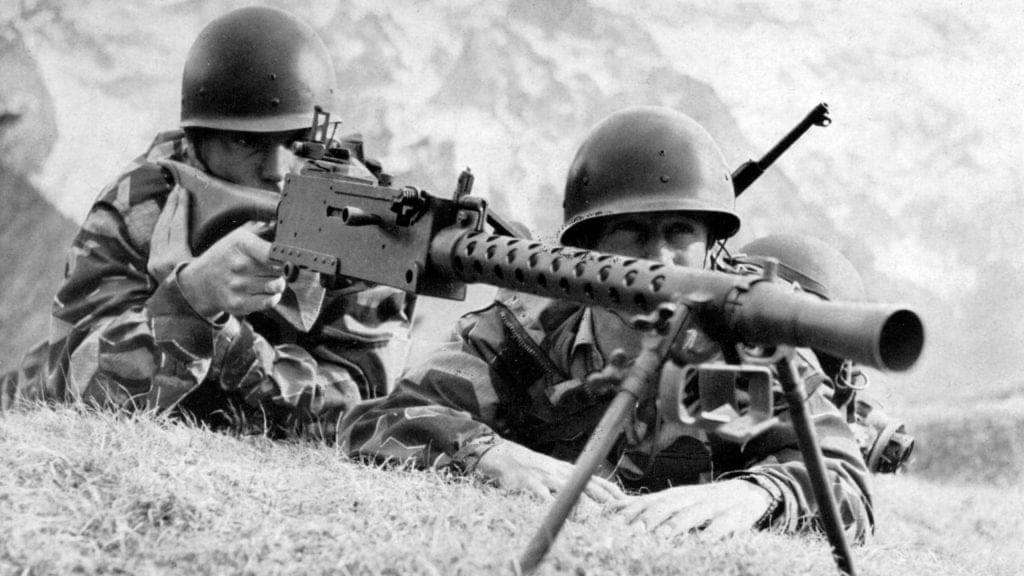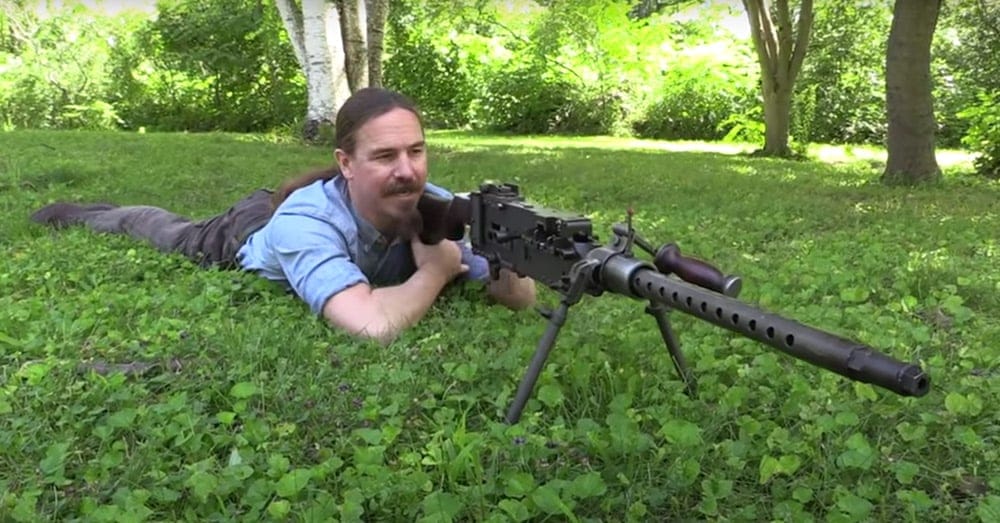Good God, do I love the United States Marine Corps. Not just because I served in the Marine Corps and because the cult brainwashing runs deep, but because of the Marine Corps attitude of improvising, overcoming, and adapting. Until recently, the Marine Corps has been famously known for receiving the Army’s leftovers. It’s why they had Springfield M1903s in World War 2 instead of Garands and why some Marines still had M16A2 rifles in Afghanistan in 2008. They made do, and in World War 2, they had quite the talent for improvisation. This resulted in the machine gun known as the M2 Stinger.
The Stinger is the nickname given to the gun by the Marines who used it. The Stinger, also known as the M2 Stinger, is a rather radical version of the M1919 machine gun. It’s not the M2 of 50-caliber fame. M2 comes from the name .30 AN/M2, which is an aviation version of the M1919 machine gun. John Browning designed the M1919 machine gun as a multi-purpose weapon. It’s a belt-fed, air or water-cooled machine gun that fired the mighty American .30-06 round and was used on aircraft, armor, Jeeps, and by the infantry.
Why the M2 Stinger Existed
To understand why the M2 Stinger came to be, we have to understand the machine gun the Marines were using at the time. Marines wielded the M1919A6, which was a specialized infantry adaption of the bulky machine gun. It was fine, not great, and it was adapted to a role it wasn’t initially designed for. The thing weighed 35 pounds. It offered more firepower than the BAR, but man, was it bulky and beastly.
The .30 AN/M2 was lighter. It weighed only 21 pounds. When it comes to aircraft, trimming weight means improving payload and fuel efficiency. The AN/M2 featured a thinner barrel and receiver.

If you’re a Marine fighting in the Pacific campaign, then 21 pounds sounds a lot better than 35 pounds. As a former machine gunner in the Marine Corps, I can’t tell you how much I would have appreciated lighter weapons. I get the logic, and so do my lower back and knees.
So how did grunt Marines get machine guns made for aircraft? Well, plenty of these aircraft had been shot out of the sky. They sat in junkyards and were often salvaged for parts. That’s where grunts first started grabbing these guns and putting them into action.
Oh, and I guess it bears mentioning that the .30 AN/M2 had a firing rate of 1,500 rounds per minute. Dog fights moved fast, and higher firing rates resulted in more shots on target per trigger burst. Let me tell you something, as a Marine machine gunner, I also appreciate higher firing rates.
The First Stingers
The Stinger machine guns were not issued weapons. They were not designed by the Navy or big Marine Corps to be used by the infantry. These were field improvised. The first came from a young private named Colby. They modified the gun with a bipod but nothing more. The Marines got caught in an ambush, and the poor Japanese didn’t know who they were messing with.
The Marines poured lead into the Japanese. Imagine the sound a gun like this makes as it pours .30-06 into you. It was a wave of lead, and the Japanese were repelled. The idea had merit, but it was still awkward with its Sapde grip and off-balanced bipod design.

Word got out, and Marine Sergeant Milan Grevich and PFC John Lyttle acted as mystical dwarven armorers and began crafting more infantry-friendly versions of the Stinger. They cut the stock from an M1 Garand and fit it to the gun, and designed a solenoid trigger to replace the spade grips. BAR sights were fitted to the weapon, and a bipod was mounted just in front of the receiver.
The two Marines developed six of these guns, and when they were done, they weighed 25 pounds. It was a little weightier but still 10 pounds lighter than the M1919A6. The machine gun fired incredibly quickly and it burned up enemy positions, likely causing immense fear and very effective suppression.

The real downside to the M2 Stinger would be the amount of ammo they would consume. I imagine everyone in the machine gun squad and associated rifle squads would carry tons of extra ammo to keep the gun fed.
Into Action
The Stingers were issued out to Company G of the 28th Marine Regiment, 5th Marine Division. The six guns were issued to machine gunners in the company’s rifle platoon, with one going to the demolition section, and Grevich carried one personally. Corporal Tony Stein carried a Stinger, and in Iwo Jima, he put it to good use. He was the first man of his unit to be on station during the initial assault.

If you had to hit the shores of that ugly little rock, you’d likely want to get hands-on with a Stinger. Who doesn’t want a lighter, faster-firing machine gun? Corporal Stein landed on Iwo Jima carrying one, and he was a one-man wrecking crew. His Stinger released a vehemence of violence against Japanese forces.
He wouldn’t be stopped. The noise and action of the Stinger would undoubtedly make Cpl. Stein a target. In fact, it made him such a target that the gun was shot out of his hands twice. But that didn’t slow down Stein the Slaughterer. He just picked it back up and let loose with it. He covered his platoon’s movement, and when they came under fire from enemy machine guns, he grabbed his gun and went to work.
The Brutality of the M2 Stinger
He took on each enemy pillbox one by one and killed 20 Japanese soldiers in his personal war on pillboxes. Remember, the gun ate through ammo, so he ended up making eight trips back to the beach to grab extra ammo. Just because his gun was empty didn’t mean he was out of ass-kicking. At the end of the day, he laid down suppressive fire to allow his allies to continue to move.

He was awarded the Medal of Honor for his work on that day. His citation even mentions the Stinger as an improvised aircraft weapon. Corporal Stein would die a week later leading a recon patrol.
The war ended, and while the M2 Stinger was effective, it faded in light of the war ending. The military and country had other priorities, and the Stinger wasn’t one of them. However, the military recognized the need for lighter support weapons. Eventually, the United States military got on board the general-purpose machine gun train and adopted the M60 and later the M240.
The M2 Stinger and the men who created it and wielded it were a credit to the Marine Corps and to their country.

